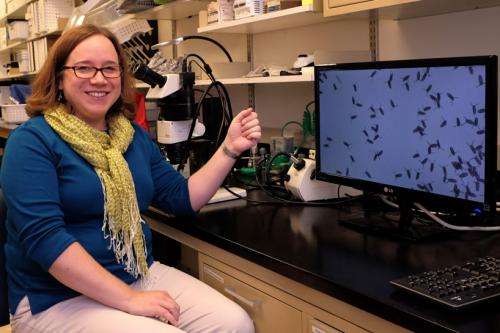UMSL scholar examines evolution of learning

Why do monkeys learn to be afraid of snakes and not flowers? Is this knowledge the result of evolution by natural selection? Did the monkeys that couldn't learn that association quickly die and not reproduce?
Aimee Dunlap, assistant professor of biology, at the University of Missouri–St. Louis, co-authored a study that tackled the age-old question of why animals learn some things more easily than others.
"Before our study, explanations of prepared learning were nothing more than Monday morning quarterbacking," said Dunlap.
Her findings appear in the paper "Experimental evolution of prepared learning," which was recently published in the Proceedings of the National Academy of Science. David Stephens, an ecology professor at the University of Minnesota in St. Paul, co-authored the paper.
"For animals to learn, they must form associations among various stimuli. However, in a world full of potential stimuli, why does a special relationship form between a given stimuli and consequence in a way that actually allows the animal to predict future events?" they wrote in the paper.
In their study, the researchers applied an evolutionary approach to the question of why some associations are learned more easily than others.
To explain this so-called prepared learning, investigators commonly appeal to the evolutionary history of stimulus-consequence relationships experienced by a population or species. The study data supports this long-held understanding that prepared learning evolves in response to reliable associations experienced by a lineage during the course of evolution.
"We offer a simple model that formalizes this long-standing hypothesis," the pair wrote in their paper. "The key variable in our model is the statistical reliability of the association between stimulus, action and consequence."
Short of enlisting a time travel machine, there's no real way to know the historical evolution of behavior. Using a simple mathematical model and fruit flies, Dunlap and Stephens created theories of when animals should form some associations better than others, based on the reliabilities of different stimuli encountered.
"We placed populations of fruit flies into experimental worlds where we manipulated these probabilities of reliability," Dunlap said. "We were able to experimentally evolve populations that learned about odor better than color and about color better than odor, as predicted by our model."
The study provides an important step forward in understanding both prepared learning and how inherited tendencies interact with information gained through experience.
Dunlap is a faculty member in UMSL's Whitney R. Harris World Ecology Center and Center for Neurodynamics.
Currently, she has two experimental evolution of learning studies running in her lab at UMSL, funded by the National Science Foundation. The experiments take around two years each and involve many undergraduate students.
More information: PNAS, www.pnas.org/content/early/201 … 176111.full.pdf+html
Journal information: Proceedings of the National Academy of Sciences
Provided by University of Missouri-St. Louis




















